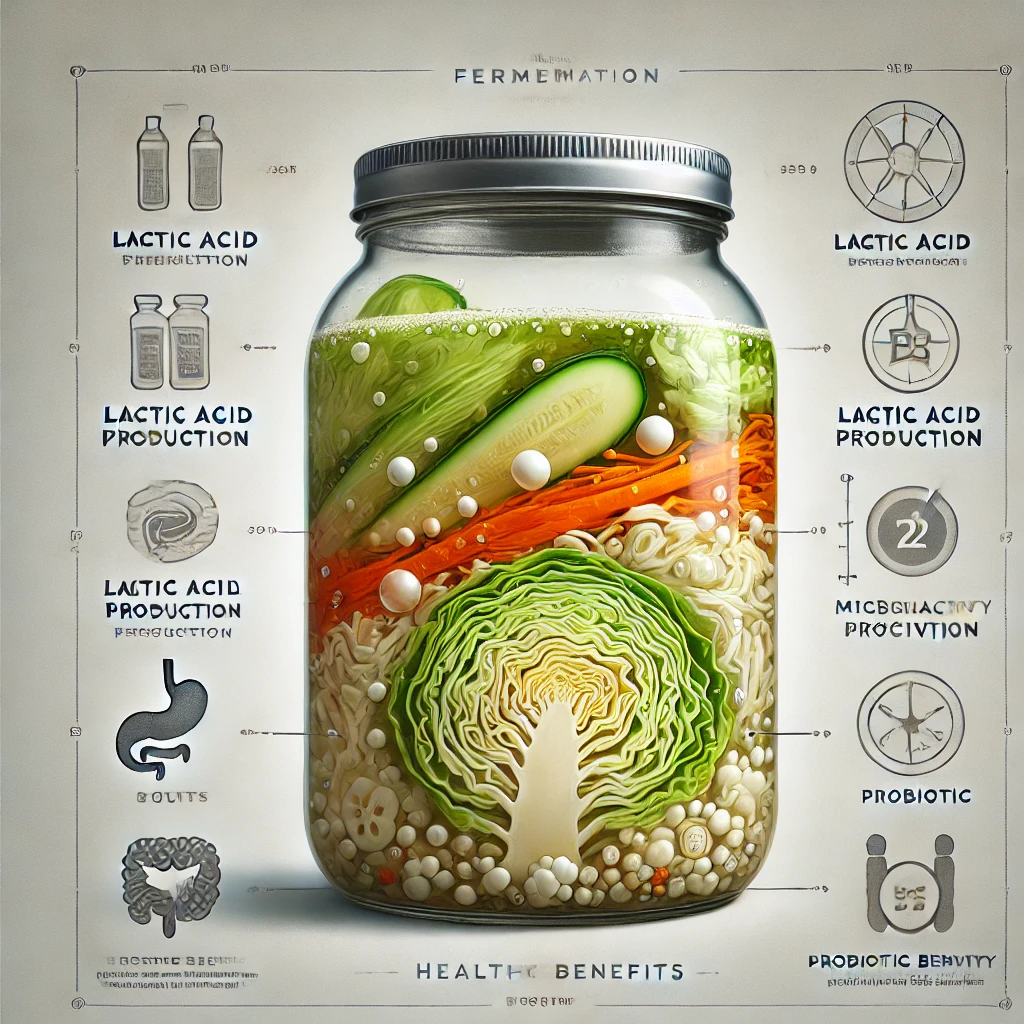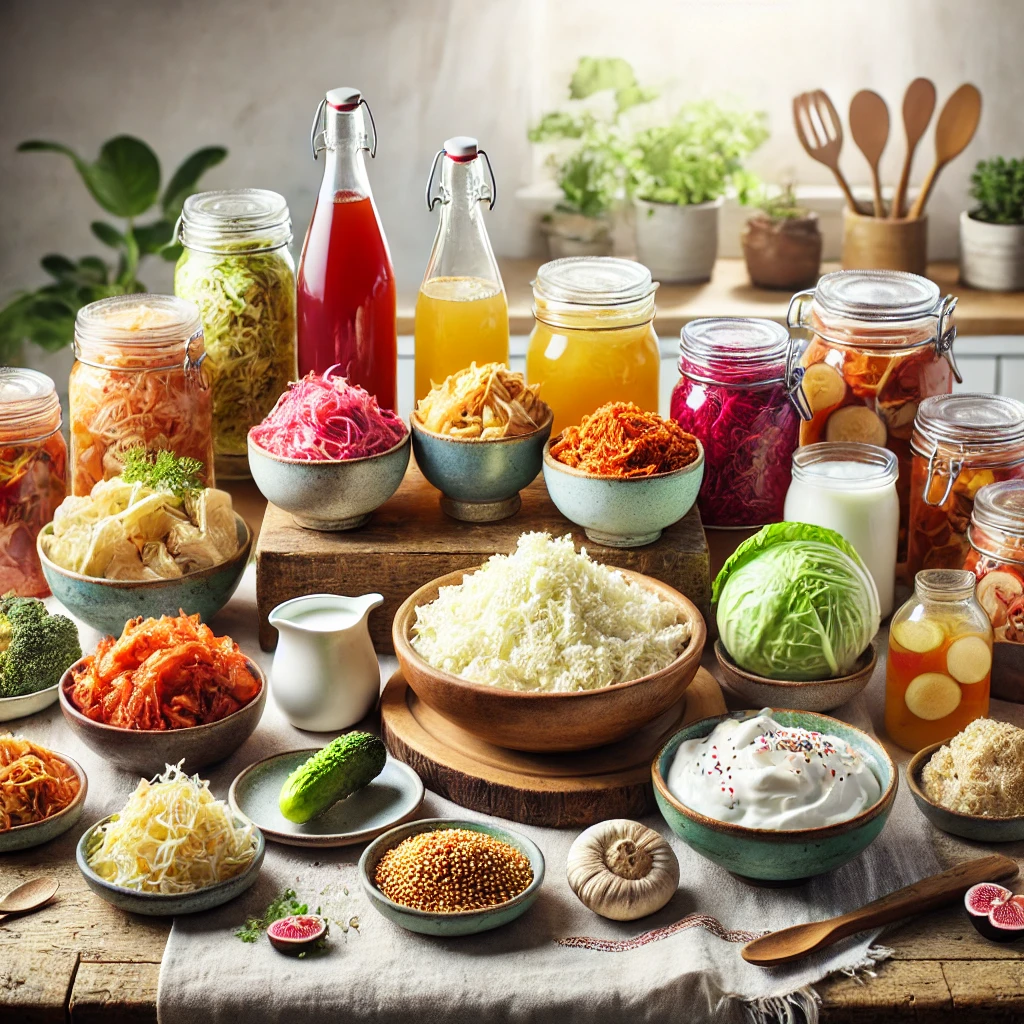Fermentation is an ancient process that has shaped human civilization, culinary traditions, and modern science. Whether you’re enjoying a glass of wine, a loaf of sourdough bread, or a bowl of yogurt, you’re experiencing the results of fermentation. But what exactly is fermentation, and how does fermentation Work? This post will delve into the intricate process of fermentation, exploring the science behind it, the different types of fermentation, its history, applications, and the health benefits it offers. If you’ve ever wondered “how fermentation works,” you’re in the right place.

The Science of Fermentation
What Is Fermentation?
Fermentation is a metabolic process that converts sugar into acids, gases, or alcohol in the absence of oxygen (anaerobic conditions). This process is carried out by microorganisms such as bacteria, yeast, and molds. The word “fermentation” comes from the Latin fervere, meaning “to boil,” likely referring to the bubbles produced by carbon dioxide during the fermentation of grape juice into wine.
In biological terms, fermentation allows cells to generate energy without relying on oxygen. While it might seem like a simple process, fermentation is a complex series of biochemical reactions that produce a wide array of end products, depending on the type of organism involved and the environmental conditions.
The Biochemistry of Fermentation
Fermentation begins with glycolysis, a process where one molecule of glucose (a simple sugar) is broken down into two molecules of pyruvate, producing a small amount of energy in the form of ATP (adenosine triphosphate). In the presence of oxygen, cells would normally continue this process through aerobic respiration to generate more ATP. However, in anaerobic conditions, cells must find an alternative way to regenerate NAD+ (nicotinamide adenine dinucleotide), a molecule required to keep glycolysis running.
Here’s where fermentation comes in:
- Lactic Acid Fermentation: In this process, pyruvate is reduced directly to lactic acid, regenerating NAD+ and allowing glycolysis to continue. Lactic acid fermentation occurs in muscle cells during intense exercise when oxygen is low and in certain bacteria used to make yogurt, sauerkraut, and pickles.
- Alcoholic Fermentation: Yeast and some types of bacteria carry out alcoholic fermentation. In this process, pyruvate is first converted into acetaldehyde and then reduced to ethanol (alcohol) and carbon dioxide. This type of fermentation is fundamental to brewing beer, making wine, and baking bread.
The specific enzymes and pathways used in fermentation vary between organisms, leading to a diverse range of fermented products.
Types of Fermentation
Understanding how fermentation works requires a look at the various types of fermentation processes. Each type of fermentation has unique characteristics and is responsible for producing different foods and beverages.
1. Lactic Acid Fermentation
Lactic acid fermentation is one of the most common types of fermentation and is responsible for the tangy flavor of yogurt, sourdough bread, and fermented vegetables like kimchi and sauerkraut.
- Organisms Involved: Lactic acid bacteria such as Lactobacillus and Streptococcus.
- Process: These bacteria convert glucose into lactic acid, which lowers the pH and creates an acidic environment that preserves the food and inhibits the growth of harmful bacteria.
- Applications: Dairy products (yogurt, kefir, cheese), fermented vegetables (sauerkraut, kimchi), sourdough bread.
Key Steps in Lactic Acid Fermentation:
- Preparation: The raw ingredients (such as milk or cabbage) are prepared and often mixed with salt, which helps to draw out water and create a brine.
- Fermentation: The lactic acid bacteria begin consuming the sugars in the food, producing lactic acid as a byproduct.
- Maturation: Over time, the increasing acidity inhibits the growth of other microorganisms, preserving the food and developing its flavor.
2. Alcoholic Fermentation
Alcoholic fermentation is the process behind the production of alcoholic beverages such as beer, wine, and spirits, as well as bread.
- Organisms Involved: Yeast, primarily Saccharomyces cerevisiae.
- Process: Yeast ferments sugars into ethanol and carbon dioxide, which in bread baking helps the dough rise and in brewing creates alcohol and carbonation.
- Applications: Beer, wine, spirits, bread.
Key Steps in Alcoholic Fermentation:
- Mashing: In brewing, grains are mashed to release fermentable sugars.
- Fermentation: Yeast is added to the sugar solution (wort in brewing, must in winemaking) and ferments the sugars into alcohol and CO₂.
- Conditioning: The fermented liquid is conditioned, where flavors develop and unwanted byproducts settle.
3. Acetic Acid Fermentation
Acetic acid fermentation is used to produce vinegar and is a process where ethanol is oxidized to acetic acid by acetic acid bacteria.
- Organisms Involved: Acetic acid bacteria, such as Acetobacter.
- Process: Ethanol is converted into acetic acid with the help of oxygen, producing vinegar.
- Applications: Vinegar (apple cider vinegar, balsamic vinegar), kombucha (a fermented tea).
Key Steps in Acetic Acid Fermentation:
- Alcohol Production: The first stage involves creating an alcohol-rich liquid (such as wine or beer).
- Acidification: The acetic acid bacteria oxidize the ethanol into acetic acid, producing vinegar.
4. Butyric Acid Fermentation
Butyric acid fermentation is less common but is important in the production of certain types of cheese and the fermentation of silage (animal feed).
- Organisms Involved: Clostridium bacteria.
- Process: These bacteria ferment sugars and lactic acid into butyric acid, producing a distinctive strong smell.
- Applications: Cheese production, silage.
5. Propionic Acid Fermentation
Propionic acid fermentation is used in the production of Swiss cheese and other foods where the characteristic holes and flavors are desired.
- Organisms Involved: Propionibacterium bacteria.
- Process: These bacteria convert lactic acid into propionic acid and carbon dioxide, which forms the holes in Swiss cheese.
- Applications: Swiss cheese, preservation of silage.
The History of Fermentation
Fermentation has a long and storied history, dating back thousands of years. The earliest evidence of fermented beverages dates to around 7,000 BCE in China, where residues of fermented rice, honey, and fruit beverages were found in ancient pottery. Throughout history, various cultures have independently developed fermentation techniques:

- Mesopotamia and Egypt: Beer and bread were staples of the diet, with beer being produced as early as 5,000 BCE. The Egyptians are credited with developing the first large-scale brewing and baking facilities.
- China and East Asia: Fermentation of soybeans into products like soy sauce, miso, and tempeh has been practiced for millennia. Fermented vegetables like kimchi in Korea and pickles in China are also ancient traditions.
- Europe: In the Middle Ages, beer brewing became a craft in monasteries, and wine production spread throughout the continent. Fermentation was essential for preserving food during the winter months.
- The Americas: Indigenous peoples in the Americas used fermentation to produce beverages like chicha and pulque, as well as to preserve fish, meat, and vegetables.
Despite its long history, the scientific understanding of fermentation didn’t emerge until the 19th century. In the 1850s and 1860s, French chemist Louis Pasteur conducted experiments that demonstrated that microorganisms such as yeast were responsible for fermentation. His work laid the foundation for the field of microbiology and the modern understanding of fermentation.
Applications of Fermentation
Fermentation is a versatile process with applications that extend far beyond food and drink. Here’s how fermentation works in various industries:

1. Food Preservation
Fermentation has been used for millennia to preserve food. The acids and alcohol produced during fermentation create an environment that inhibits the growth of harmful bacteria, allowing food to be stored for long periods without spoiling. This was particularly important before the advent of refrigeration.
- Examples: Sauerkraut, kimchi, pickles, yogurt.
2. Alcohol Production
Alcoholic beverages are one of the most well-known products of fermentation. The process of fermenting sugars into ethanol is the foundation of the brewing and winemaking industries.
- Examples: Beer, wine, spirits, mead.
3. Dairy Products
Fermentation is integral to the production of many dairy products. Lactic acid bacteria convert lactose (milk sugar) into lactic acid, which thickens the milk and gives it a tangy flavor. Different bacteria and fermentation times create a variety of textures and flavors in dairy products.
- Examples: Yogurt, kefir, cheese, sour cream.
4. Bread Making
In bread making, yeast fermentation is used to leaven dough. Yeast ferments the sugars in the dough, producing carbon dioxide gas that makes the dough rise. Sourdough bread, in particular, relies on natural fermentation with wild yeast and lactic acid bacteria.
- Examples: Sourdough, rye bread, brioche.
5. Biofuel Production
Fermentation is also used in the production of biofuels, particularly ethanol. Corn, sugarcane, and other biomass are fermented to produce ethanol, which can be used as a renewable fuel source. This process is essential to global efforts to reduce reliance on fossil fuels.
This site is a participant in the Amazon Services LLC Associates Program and contains affiliate links to products. We may receive a commission for purchases made through these links.